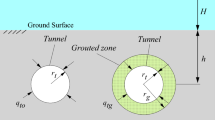Abstract
In operational projects, injection pressure and cement bonding in boreholes are estimated based on the results of geotechnical excavations, the Lugeon test, and pilot injection. However, considering the limited number of pilot boreholes and several structural complexities of rock mass, estimating the structural characteristics of injection boreholes is always associated with errors and in some cases grave mistakes. The present paper focuses on a new approach to determine the exact rock mass engineering characteristics in different parts of the Khersan Dam area. Using geostatistical principles, drawing changes in views, and preparation of an interpolated block model, values such as RQD and Lugeon over different parts of the dam site were estimated by kriging. A solution for determining the amount of pressure required and the cement bonding at any point of the dam axis was also proposed. The results showed that, with the transition from surface horizons to depth, neither cement bonding nor injection pressure were normal and exhibited no specific trend. Accordingly, to achieve optimum results, the engineering characteristics of rock masses in the column of each borehole were estimated; injection design and estimation of required pressure must be done on the spots with regard to the engineering characteristics changes.












Similar content being viewed by others
References
Akhondi M, Mohammadi Z (2014) Preliminary analysis of spatial development of karst using a geostatistical simulation approach. Bull Eng Geol Environ 73(4):1037–1047
Assari A, Mohammadi Z (2017) Analysis of rock quality designation (RQD) and Lugeon values in a karstic formation using the sequential indicator simulation approach, Karun IV Dam site, Iran. Bull Eng Geol Environ 76(2):771–782
Azimian A, Ajalloeian R (2015) Permeability and groutability appraisal of the Nargesi dam site in Iran based on the secondary permeability index, joint hydraulic aperture and Lugeon tests. Bull Eng Geol Environ 74:845–859
Bushara MN, Tawel AE, Borougha H, Dabbouk C, Qotb M (2002) Effective permeability modeling: geostatistical integration of permeability indicators. In: Proceedings of the Abu Dhabi international petroleum exhibition and conference. Abu Dhabi, United Arab Emirates, p 894
Ewert FK (1985). Practical criteria for determining grouting methods considering rock-type-specific groutability. In: Rock grouting. Springer, Berlin
Ewert FK (1997) Permeability, groutability and grouting of rocks related to dam sites. Dam Engineering 8(2):123–176
Grundy CF (1955) The treatment by grouting of permeable foundations of dams. In: Proceedings of the 5th Congress on Large Dams. Wiley, New York, p 791
Gurocak Z, Alemdag S (2012) Assessment of permeability and injection depth at the Atasu dam site (Turkey) based on experimental and numerical analyses. Bull Eng Geol Environ 71(2):221–229
Li X, Zhong D, Ren B (2017) Prediction of curtain grouting efficiency based on ANFIS. Bull Eng Geol Environ. https://doi.org/10.1007/s10064-017-1039-y
Lin P, Zhu X, Li Q, Liu H, Yu Y (2016) Study on optimal grouting timing for controlling uplift deformation of a super high arch dam. Rock Mech Rock Eng 49(1):115–142
Milanovic PT (2004) Water resources engineering in karst. CRC press, Boca Raton, 312 p
Nikbakht B, Anangari K, Rahmani N (2010) Estimation of jet grouting parameters in Shahriar dam, Iran. Min Sci Technol (China) 20(3):472–477
Nonveiller E (1989) Grouting, theory, and practice. Elsevier, Amsterdam, p 250
Peng W, Dong Z, Guo C (2009) Theoretical study on multiple holes grouting with natural boundary element method. Procedia Earth Planet Sci 1(1):465–470
Rostami Barani HR, Khatib MM (2015) Back analysis of grout treatment at Sumbar dam using the joint hydraulic factor. Rock Mech Rock Eng 48:2485–2488
Sohrabi-Bidar A, Rastegar-Nia A, Zolfaghari A (2016) Estimation of the grout take using empirical relationships (case study: Bakhtiari dam site). Bull Eng Geol Environ 75(2):425–438
Acknowledgments
The authors would like to thank the head of Aban Pazhouh Consulting Company and the experts who gave us the valuable data and aid us during our research. The authors would like to thank the Associate Editor and the anonymous referees for their insightful comments.
Author information
Authors and Affiliations
Corresponding author
Rights and permissions
About this article
Cite this article
Abdollahisharif, J., Bakhtavar, E. Using geostatistical simulation to determine optimal grout injection pressure in dam foundation based on geomechanical characteristics. Bull Eng Geol Environ 78, 2253–2266 (2019). https://doi.org/10.1007/s10064-018-1289-3
Received:
Accepted:
Published:
Issue Date:
DOI: https://doi.org/10.1007/s10064-018-1289-3




